Visual Exegesis of Herodias and Salome from Feminist Rhetorical Criticism: The Construction of a Myth
Abstract
1. Introduction
2. Portraits of Herodias and Salome, according to Flavius Josephus
[…] Herodias […] was married to Herod [Philip], the son of Herod the Great, who was born of Mariamne, the daughter of Simon the high priest, who had a daughter, Salome; after whose birth Herodias took upon her to confound the laws of our country, and divorced herself from her husband while he was alive, and was married to Herod [Antipas], her husband’s brother by the father’s side; he was tetrarch of Galilee; but her daughter Salome was married to Philip, the son of Herod, and tetrarch of Trachonitis.(Ant., XVIII, V, 136)
From Archeology to Texts
3. The Framework of Biblical–Cultural Studies: Feminist Rhetorical Criticism
3.1. Salome “Must” Dance. A Gender-Critical Reading of the Biblical Passage
3.2. From Visual Exegesis: Illuminating Feminist Rhetorical Criticism
4. The Visual Reception of Myth: From Nameless Girl to Femme Fatale
4.1. The Stele of the Demonic Hebrew Lilith
For many, seeing women outside of their maternal and conjugal roles translated into fear and anxiety. Outside of these traditional roles, she appeared as a usurper, and therefore, threatening, since she endangered the stability and continuity of institutions and established rights and privileges.
The femme fatale is the one seen once and always remembered. These women are disasters of which traces always remain in the body and soul. Some men kill themselves for them, others who go astray.(Cited in Bornay 1995, p. 114)
4.2. Fin-de-Siècle Painting
5. Origins in Literature: From Flaubert to Strauss
With her eyelids half closed, she twisted her waist, her belly swayed with wave-like undulations, she made her two breasts tremble and her face remained motionless and her feet did not stop19 (…) Then were the transports of the love that wants to be satisfied (…) everyone, dilating their nostrils, throbbed with desire.(1877, cited in Bornay 1995, pp. 190–92)
6. Conclusions
Funding
Institutional Review Board Statement
Informed Consent Statement
Data Availability Statement
Acknowledgments
Conflicts of Interest
| 1 | From New Testament exegesis, the passage of the beheading of John the Baptist is analyzed as a foreshadowing of the death of Christ (for more information, consult Dapaah (2005)). A phenomenon that transcended textual criticism and also had its reflection in the pictorial world, mainly in the late Middle Ages and early Modern Age (Baert 2019). |
| 2 | All biblical references have been consulted in the Jerusalem Bible (1992), so this information will be omitted from now on. |
| 3 | Reference is made in the New Testament to a woman named Salome, within the context of Jesus’ followers, hence she is known as one of his disciples, one of his followers. She appears only in the Gospel of Mark (15:40 and 16:1). The association of the name Salome with the figure of Herodias’ daughter was also important in exegesis due to the role of Theodore de Beza (1519–1605), a French reformer and successor to John Calvin in Geneva, who promoted in the Geneva Bible of 1560 this nominative association. The Geneva Bible of 1560 was used by the early Calvinist reformers, in which extensive commentary and notes on passages from the Old and New Testaments appeared (Krans 2006). It is in one of these commentaries where extratextual assessments of the passage of Herodias and her daughter were expressed, indicating that Salome’s dance brought inconveniences; even in a marginal note, it is mentioned as a wanton dance. (Metzger 1960, p. 349). |
| 4 | From now on Ant. |
| 5 | |
| 6 | From now on Bell. |
| 7 | In the Gospels, the name of the place outside the walls of Jerusalem where Jesus was crucified. Also called Calvary (a term assimilated from Latin) and whose translation means “place of the skull” (Mt 27:33; Mk 15:22; Jn 19:17). |
| 8 | The archaeological campaigns in Machaerus began in 1807 and different institutions have participated in their excavation work: the American Baptist Churches, the Order of Franciscan Friars, and finally the Hungarian Academy of Arts (Vörös 2022). |
| 9 | Thanks to the development of cultural studies in the 90s in Great Britain and the United States, Biblical Sciences were influenced by this new trend, giving rise to Biblical–cultural Studies (Yebra 2022, pp. 57–61). |
| 10 | The term was developed by Kimberly Crenshaw (Schüssler Fiorenza 2014, p. 11) which encompasses a new system of analysis of reality/context taking into account ethnicity, gender, sexuality, class, domination... To delve deeper into the methodology, see Lykke (2010). |
| 11 | A neologism coined by Elisabeth Schüssler Fiorenza in 1992 composed of the Greek word kyrios (lord) and the Greek verb archein (to rule, dominate). This term refers to a social system based on graded domination over individuals, which goes far beyond the limits of patriarchy since kyriarchy is not based on gender issues. Kyriarchism implies the subordination of a “servant class” to an “elevated class”, so it contemplates any dominant hierarchy maintained through law, mentality, and/or imposition (Schüssler Fiorenza 2014, pp. 12–14). |
| 12 | |
| 13 | As researcher Gerardus Van der Leeuw stated in his studies on the relationship between religion and art: “The art of the dance is even more primitive than verbal art. Here rhythm is all-powerful, it rules the whole man and compels them to follow the right path” (Van der Leeuw 1963). In this type of analysis, bodily gesturality becomes the primary channel of communication among humans and between them and the gods, with dance -understood broadly as bodily movement- being a fundamental aspect of ritual praxis. Researcher Diane Apostolos-Cappadona examines the role of dance and women who dance in the Bible through the Western visual tradition, concluding that there are two unique women who dance in the Hebrew and Christian traditions and serve as paradigms for analysis: Miriam and Salome, respectively. While the former dances in joy for the escape from Egyptian slavery, embodying piety and faith, the latter dances by request and pleasure of a man, representing wickedness and the erotic. Thus, dance becomes another element of visual rhetoric to be analyzed in biblical narratives, carrying diverse meanings through exegesis. For a more in-depth exploration of this aspect, refer to Adams and Apostolos-Cappadona (1990). |
| 14 | Understanding the term “image” in all its flexibility of meaning, where not only the object of study is limited to a painting, a sculpture, or an architectural work, but the field of aesthetics is expanded to other manifestations such as the performing arts, conceptual art, or digital art, among others (Nygren 2017, p. 271). |
| 15 | The historian of religions and theologian, Othmar Keel, specialized in biblical exegesis and iconography of the ancient Near East. His works were fundamental in the consolidation of the iconographic discipline as an academic and methodological tool in Biblical Studies. His main work is called The Symbolism of the Biblical World: Ancient Near Eastern Iconography and the Book of Psalms (Othmar 1978). |
| 16 | During the Rococo and Neoclassical art periods, biblical passages are difficult to find in painting, as secular themes such as still lifes, genre scenes, historical, or mythological subjects predominate. However, the 19th century witnessed a shift with Romantic thought, leading to a revival of religious themes in artistic interest, although not always with a pious or worshipful purpose. A notable example of this is the figure of Salome, which will become one of the most popular representations of symbolism. Such is the case that the French artist Gustav Moreau, a precursor of Symbolism, “was obsessed with Salome. He created over one hundred images of her, all of which would influence the writers and dancers of the next twenty years” (Adams and Apostolos-Cappadona 1990, p. 103). |
| 17 | The term femme fatale was coined a posteriori after the identification of a new type of woman brought about by a new way of acting for women in the second half of the 19th century (Bornay 1995, p. 113). |
| 18 | Specifically in the Ben Sira Alphabet, dated to the 8th century CE (Blair 2009, p. 28). |
| 19 | The dance that Salome performs in this short story is greatly influenced by a previous work by Gustave Flaubert, Salammbo (1862), where the dance performed by the daughter of the general of Carthage, Amílcar Barca, with a python is recounted with great complicity and a high degree of eroticism. This also facilitated the establishment of the association of the bad woman with the snake animal. |
| 20 | Term used by the 5th century Syriac poet and theologian, Narsai of Nisibe, in his homily 80, to refer to women in general, denoting their negative character (Molenberg 1993). Other authors have used similar names referring to the personification of women as descendants of some woman considered “bad” by history: such as “daughters of Lilith” (Bornay 1995) or “daughters of Pandora” (Calero Secall and Virginia Alfaro Bech Coordinators 2005). |
References
- Adams, Rouge, and Diane Apostolos-Cappadona, eds. 1990. Dance as Religious Studies. New York: The Crossroad Publishing Company. [Google Scholar]
- Albertz, Rainer. 2011. The controversy about Judean versus Israelite identity and the Persian government: A new interpretation of the Bagoses story (Jewish antiquities XI.297–301). In Judah and the Judeans in the Achaemenid Period: Negotiating Identity in an International Context. Edited by Oded Lipschits, Gary N. Knoppers and Manfred Oeming. University Park: Penn State University Press, pp. 483–504. [Google Scholar] [CrossRef]
- Baert, Barbara. 2019. The Johannesschüssel as Andachtsbild: The Gaze, the Medium, and th Senses. In Interruptions and Transitions: Essays on the Senses in Medieval and Early Modern Visual Culture. Edited by Sarah Blick and Laura D. Gelfand. Leiden: Brill, pp. 131–68. [Google Scholar]
- Blair, Judit M. 2009. De-Demonising the Old Testament. An Investigation of Azazel, Lilith, Deber, Qteb and Reshef in the Hebrew Bible. Tübingen: Mohr Siebeck. [Google Scholar]
- Bornay, Erika. 1995. Las Hijas de Lilith. Madrid: Cátedra Ensayos Arte. [Google Scholar]
- Bornay, Erika. 2021. La Cabellera Femenina. Madrid: Cátedra Ensayos Arte. [Google Scholar]
- Calero Secall, Inés M., and Virginia Alfaro Bech Coordinators. 2005. Las Hijas de Pandora: Historia, Tradición y Simbología. Málaga: Servicio de Publicaciones de la Universidad de Málaga. [Google Scholar]
- Dapaah, Daniel S. 2005. The Relationship between John the Baptist and Jesus of Nazareth: A Critical Study. New York: University Press of America. [Google Scholar]
- de Hulster, Izaak J. 2009a. Illuminating Images. A Historical Position and Method for Iconographic Exegesis. In Iconography and Biblical Studies, Proceedings of the Iconography Sessions at the Joint EABS/SBL Conference, Vienna, Austria, 22–26 July 2007. Edited by Izaak J. de Hulster and Rüdiger Schmitt. Münster: Ugarit-Verlag, pp. 225–32. [Google Scholar]
- de Hulster, Izaak J. 2009b. What is an Image? A Basis for Iconographic Exegesis. In Iconography and Biblical Studies, Proceedings of the Iconography Sessions at the Joint EABS/SBL Conference, Vienna, Austria, 22–26 July 2007. Edited by Izaak J. de Hulster and Rüdiger Schmitt. Münster: Ugarit-Verlag, pp. 225–32. [Google Scholar]
- Glancy, Jennifer A. 1994. Unveiling Masculinity. The Construction of Gender in Mark 6:17–29. Biblical Interpretation, a Journal of Contemporary Approaches 2: 34–50. [Google Scholar] [CrossRef]
- Graves, Robert, and Raphael Patai. 1986. Los Mitos Hebreos. Madrid: Alianza Editorial. [Google Scholar]
- Hamidović, David, ed. 2013. La Rumeur Salomé. Paris: Les Éditions du Cerf. [Google Scholar]
- Ilan, Tal. 1996. Josephus and Nicolaus on Women. In Geschichte-Tradition-Reflexion. Festschrift für Martin Hengel zum 70. Geburtstag. Tübingen: J.C.B. Mohr (Paul Siebeck), pp. 221–62. [Google Scholar]
- Janes, Regina. 2006. Why the Daughter of Herodias Must Dance (Mark 6. 14–29). Journal for the Study of the New Testament 284: 444–67. [Google Scholar] [CrossRef]
- Jerusalem Bible. 1992. Bruges: Desclée de Brouwer.
- Jones, Arnold Hugh Martin. 1938. The Herods of Judaea. Oxford: Oxford University Press. [Google Scholar]
- Kraemer, Ross S. 2006. Implicating Herodias and Her Daughter in the Death of John the Baptizer: A (Christian) Theological Strategy? Journal of Biblical Literature 125: 321–49. [Google Scholar] [CrossRef]
- Krans, Jan. 2006. Beyond What Is Written: Erasmus and Beza as Conjectural Critics of the New Testament. Leiden: Brill. [Google Scholar]
- Lillie, Williams. 1954. Salome or Herodias? The Expository Times 65: 251. [Google Scholar]
- Lykke, Nina. 2010. Feminist Studies: A Guide to Intersectional Theory, Methodology, and Writing. London: Routledge. [Google Scholar]
- Martínez Cano, Silvia. 2021. Teología Feminista para Principiantes. Voces de Mujeres en la Teología Actual. Madrid: San Pablo. [Google Scholar]
- McDonald, Beth E. 2009. In Possession of the Night: Lilith as Goddess, Demon, Vampire. In Sacred Tropes: Tanakh, New Testament, and Qur’an as Literature and Culture. Edited by Roberta Sabbath. Leiden: Brill, pp. 173–82. [Google Scholar] [CrossRef]
- Metzger, Bruce M. 1960. The Geneva Bible of 1560. Theology Today 17: 339–52. [Google Scholar] [CrossRef]
- Molenberg, Corrie. 1993. Narsai’s Memra on the Reproof of Eve’s Daughters and the “Tricks and Devices” they Perform. Le Muséon, Revue d’Études Orientales 106: 65–87. [Google Scholar] [CrossRef]
- Morgan Gillman, Florence. 2003. Herodias, at Home in That Fox’s Den. Collegeville: Liturgical Press. [Google Scholar]
- Nygren, Cristopher J. 2017. Graphic Exegesis: Reflections on the Difficulty of Talking About Biblical Images, Pictures, and Texts. In The Art of Visual Exegesis. Rethoric, Texts, Images. Edited by Vernon K. Robbins, Walter S. Melion and Roy R. Jeal. Atlanta: SBL Press, pp. 271–302. [Google Scholar]
- Othmar, Keel. 1978. The Symbolism of the Biblical World: Ancient Near Eastern Iconography and the Book of Psalms. New York: Seabury Book Service. [Google Scholar]
- Panofsky, Erwin. 1972. Studies in Iconology: Humanistic Themes in the Art of the Renaissance. New York: Icon Editions. [Google Scholar]
- Rodríguez Fonseca, Delfina P. 1997. Salomé: La influencia de Oscar Wilde en las Literaturas Hispánicas. Oviedo: KRK Ediciones. [Google Scholar]
- Schmitt, Rüdiger. 2009. The Iconography of Power. Israelite and Judean Royal Architecture as Icons of Power. In Iconography and Biblical Studies, Proceedings of the Iconography Sessions at the Joint EABS/SBL Conference, Vienna, Austria, 22–26 July 2007. Edited by Izaak J. de Hulster and Rüdiger Schmitt. Münster: Ugarit-Verlag, pp. 73–91. [Google Scholar]
- Schneider, Rolf M. 2006. Orientalism in Late Antiquity. The Oriental in Imperial and Christian Imagery. In Ērān und Anērān. Studien zu den Beziehungen Zwischen dem Sasanidenreich und der Mittelmeerwelt. Beiträge des Internationalen Colloquiums in Eutin, 8–9 June 2000. Edited by Josef Wiesehöfer and Philip Huyse. Stuttgart: Franz Steiner Verlag, pp. 241–78. [Google Scholar] [CrossRef]
- Scholz, Susanne. 2013. Introduction: The Past, the Present, and the Future of Feminist Hebrew Bible Interpretation. In Feminist Interpretation of the Hebrew Bible in Retrospect. Edited by Susanne Scholz. Sheffield: Sheffield Phoenix Press, pp. 1–10. [Google Scholar]
- Schüssler Fiorenza, Elisabeth. 1996. Challenging the Rhetorical Half-Turn: Feminist and Rhetorical Biblical Criticism. In Rhetoric, Scripture & Theology. Edited by Stanley E. Porter and Thomas H. Olbricht. Sheffield: Sheffield Academic Press, pp. 28–53. [Google Scholar]
- Schüssler Fiorenza, Elisabeth. 2014. Between Movement and Academy: Feminist Biblical Studies in the Twentieth Century. In Feminist Biblical Studies in the Twentieth Centuries: Scholarship and Movement. Edited by Elisabeth Schüssler Fiorenza. Atlanta: SBL Press, pp. 1–17. [Google Scholar] [CrossRef]
- Strickert, Frederick. 2014. A Fresh Analysis of Josephus’ Portrayal of Herodias, Wife of Herod’s Son. In Bethsaida in Archaeology, History and Ancient Culture. A Festschrift in Honor of John T. Greene. Edited by J. Harold Ellens. Newcastle upon Tyne: Cambridge Scholars Publishing, pp. 360–94. [Google Scholar]
- Trible, Phyllis. 1973. Depatriarchalizing in Biblical Interpretation. Journal of the American Academy of Religion 41: 30–48. [Google Scholar] [CrossRef]
- Trible, Phyllis. 1978. God and the Rhetoric of Sexuality. Washington, DC: Fortress Press. [Google Scholar]
- Trible, Phyllis. 1994. Rethorical Criticism: Context, Method, and the Book of Jonah. Washington, DC: Fortress Press. [Google Scholar]
- Van der Leeuw, Gerardus. 1963. Sacred and Profane Beauty. The Holy in Art. New York: Holt, Rhinehart, and Winston. [Google Scholar]
- Vörös, Gyözö. 2015. Machaerus II, The Hungarian Archaeological Mission in the Light of the American-Baptist and Italian-Franciscan Excavations and Surveys (Final Report, 1968–2015). Milan: Edizioni Terra Santa. [Google Scholar]
- Vörös, Gyözö. 2022. Machaerus III, the Golgotha of John the Baptist. The Herodian Royal City Overlooking the Dead Sea in Transjordan, Where Princess Salome Danced (Archaeological Excavations of the Hungarian Academy of Arts, 2009–2021). Budapest: Magyar Müvészeti Akadémia. [Google Scholar]
- Whealey, Alice. 2003. Josephus on Jesus: The Testimonium Flavianum Controversy from Late Antiquity to Modern Times. Lausanne: Peter Lang, Inc. [Google Scholar]
- Whiston, William, and Paul L. Maier. 1999. The New Complete Works of Josephus. Grand Rapids: Kregel Publications. [Google Scholar]
- Yebra, Carmen. 2022. Qué se Sabe de … La Biblia y el Arte Occidental. Madrid: Editorial Verbo Divino. [Google Scholar]
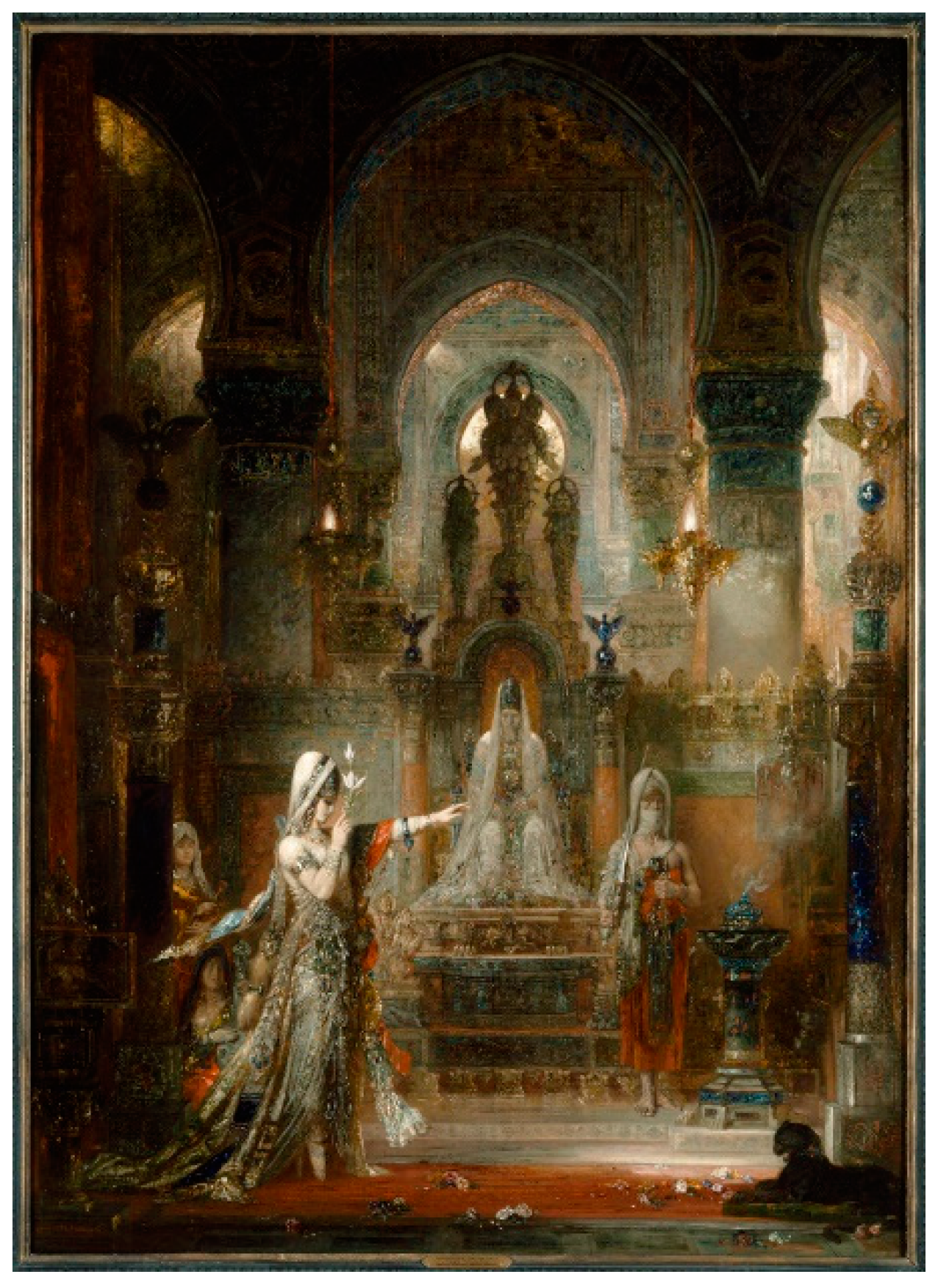


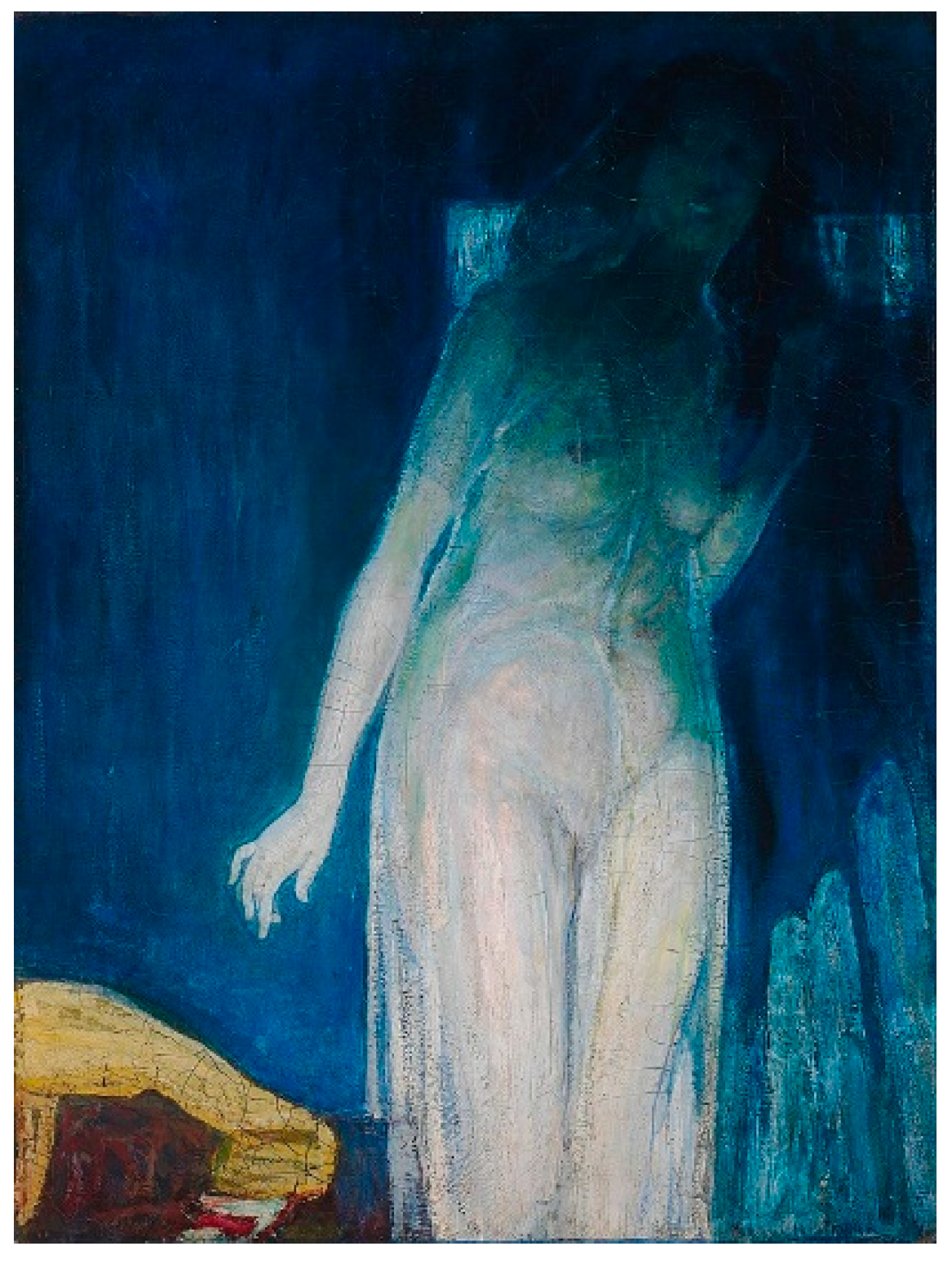


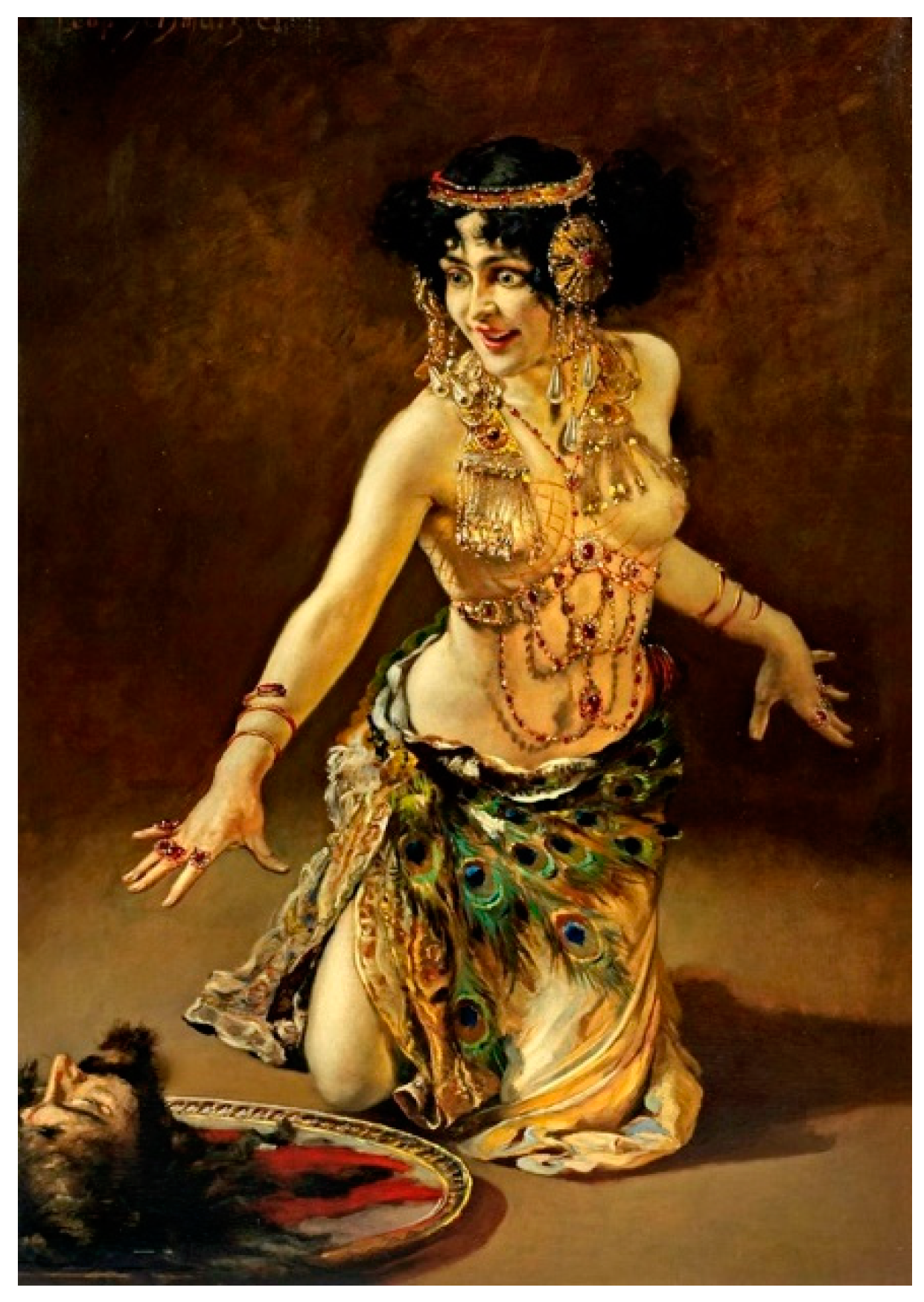
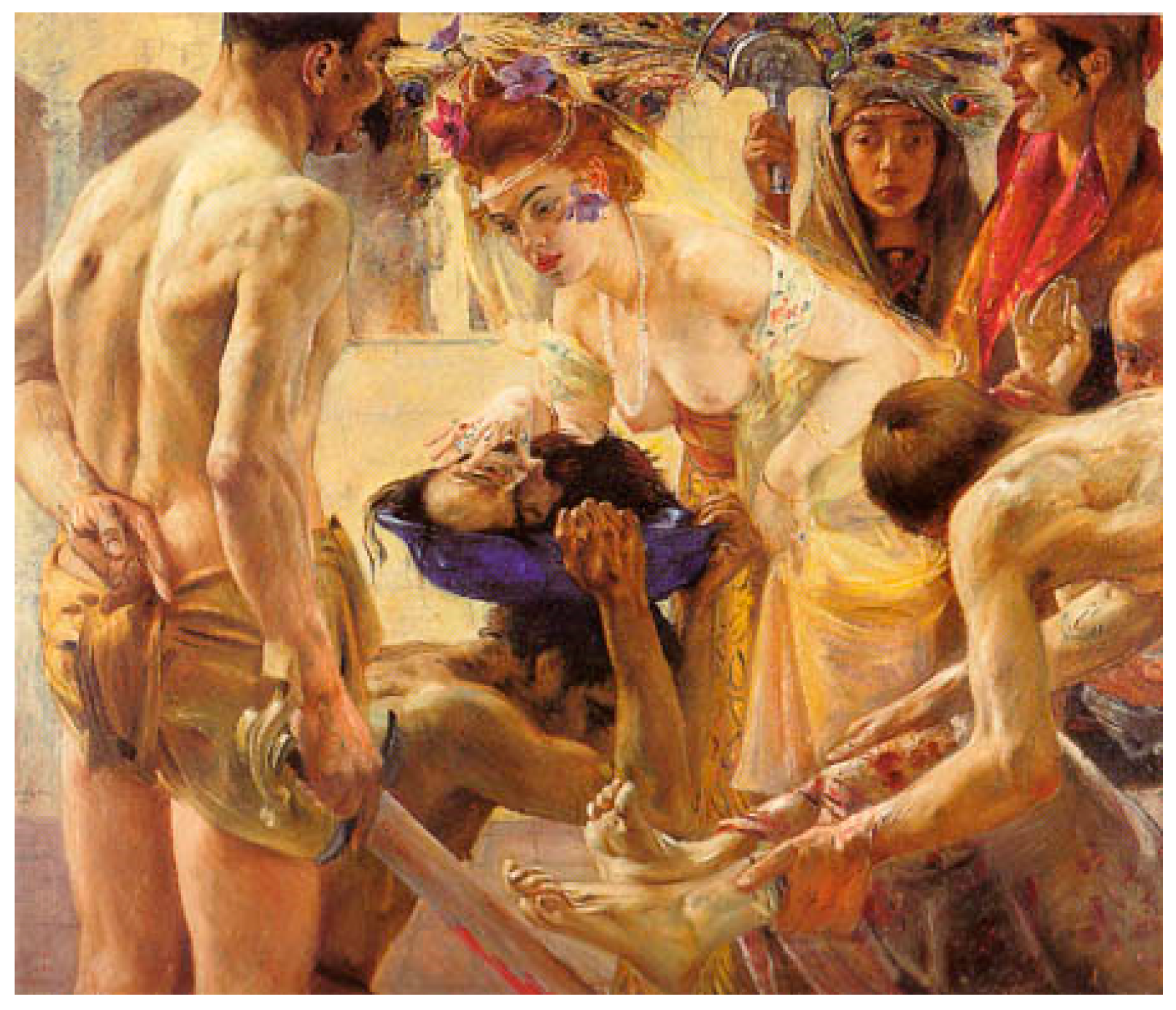
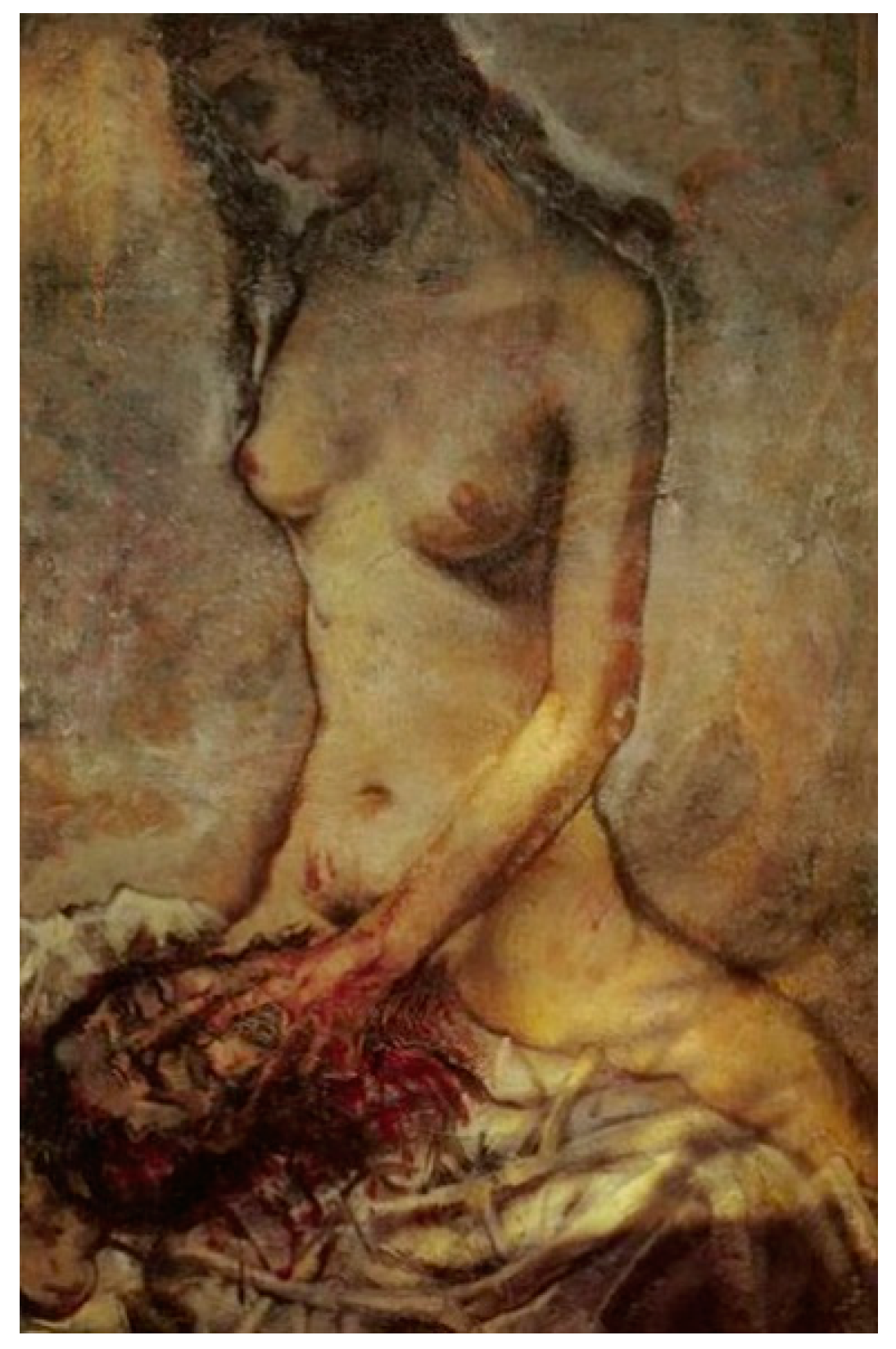
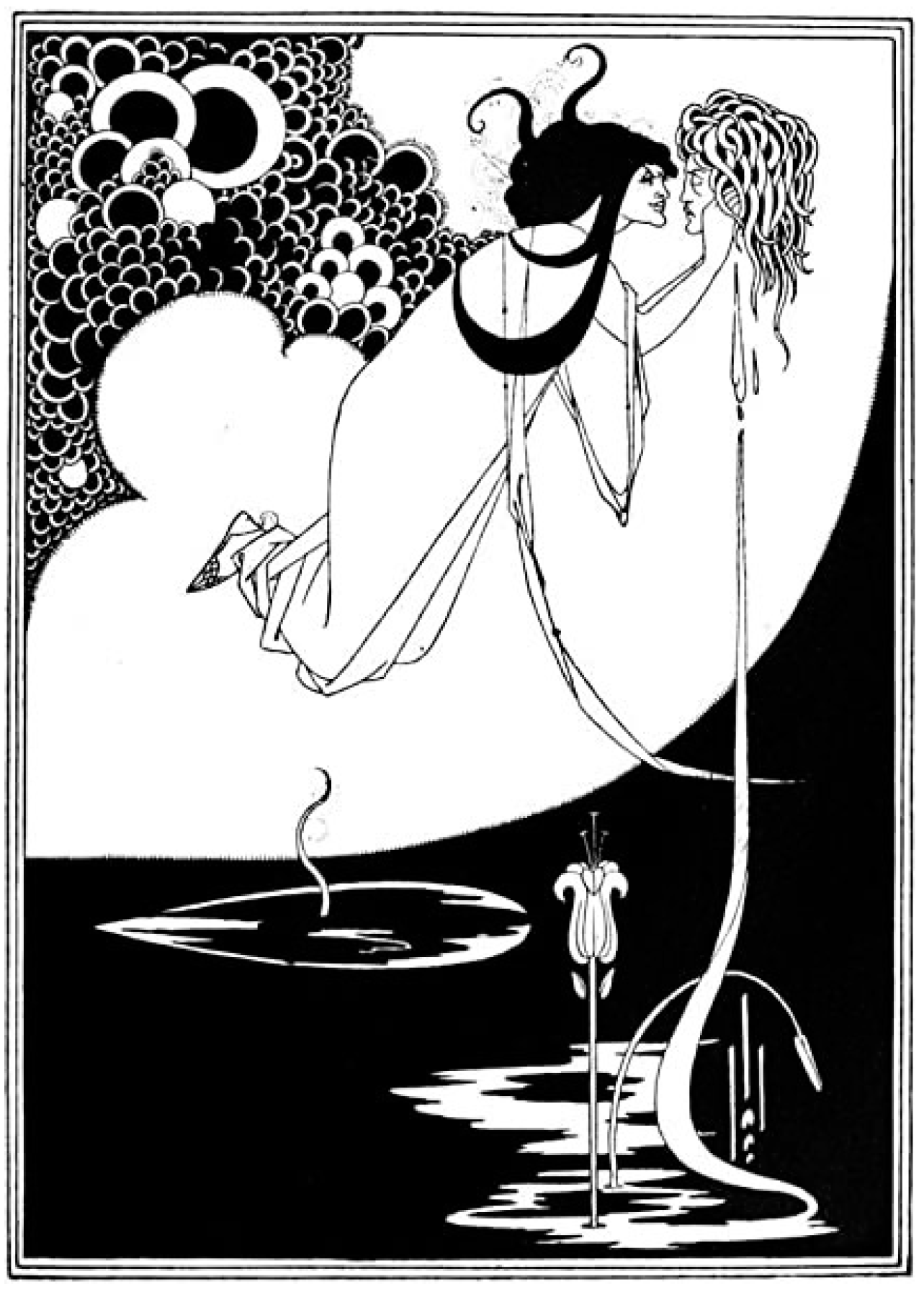
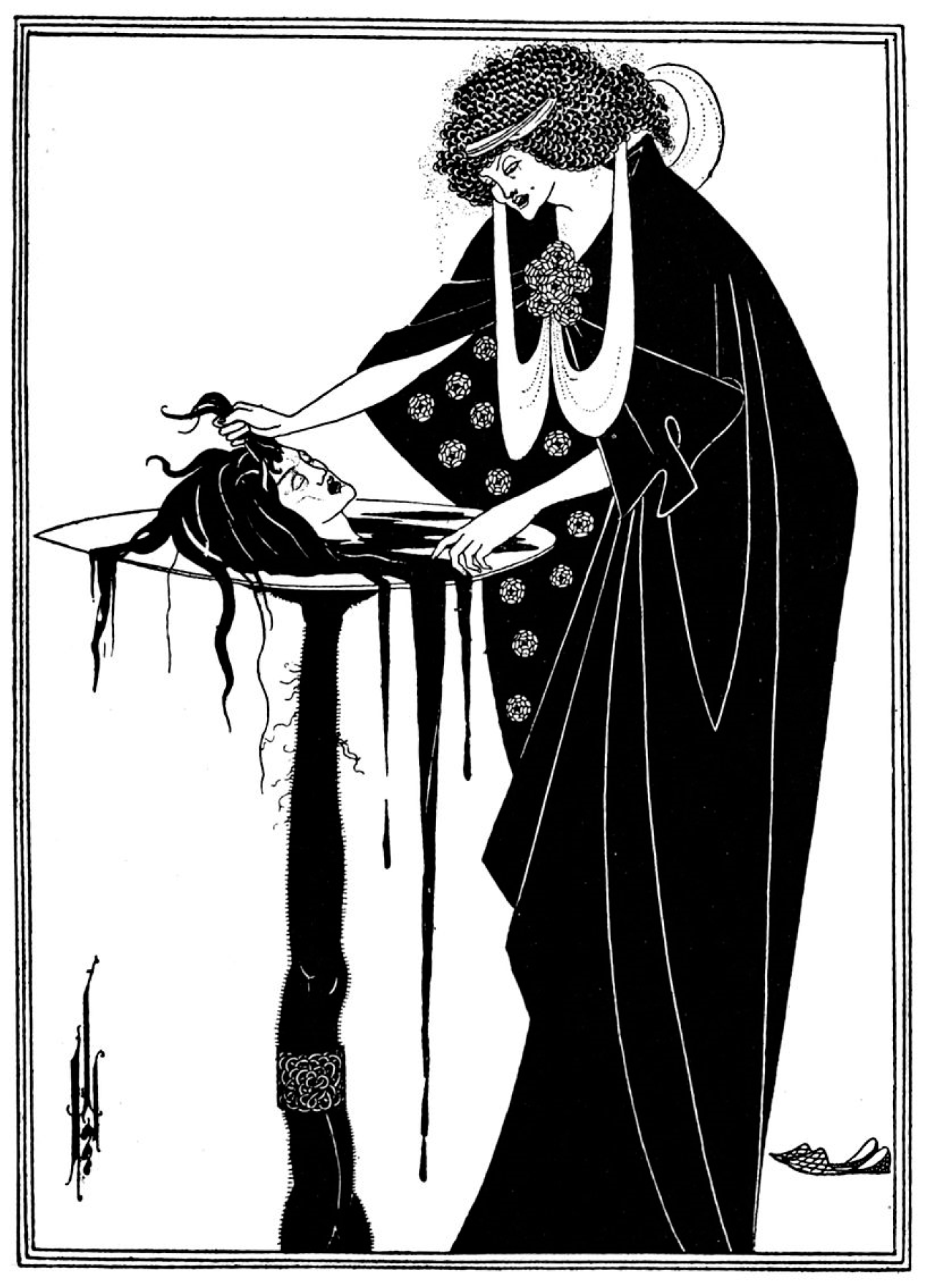
Disclaimer/Publisher’s Note: The statements, opinions and data contained in all publications are solely those of the individual author(s) and contributor(s) and not of MDPI and/or the editor(s). MDPI and/or the editor(s) disclaim responsibility for any injury to people or property resulting from any ideas, methods, instructions or products referred to in the content. |
© 2024 by the author. Licensee MDPI, Basel, Switzerland. This article is an open access article distributed under the terms and conditions of the Creative Commons Attribution (CC BY) license (https://creativecommons.org/licenses/by/4.0/).
Share and Cite
Expósito de Vicente, C. Visual Exegesis of Herodias and Salome from Feminist Rhetorical Criticism: The Construction of a Myth. Religions 2024, 15, 328. https://doi.org/10.3390/rel15030328
Expósito de Vicente C. Visual Exegesis of Herodias and Salome from Feminist Rhetorical Criticism: The Construction of a Myth. Religions. 2024; 15(3):328. https://doi.org/10.3390/rel15030328
Chicago/Turabian StyleExpósito de Vicente, Cristina. 2024. "Visual Exegesis of Herodias and Salome from Feminist Rhetorical Criticism: The Construction of a Myth" Religions 15, no. 3: 328. https://doi.org/10.3390/rel15030328
APA StyleExpósito de Vicente, C. (2024). Visual Exegesis of Herodias and Salome from Feminist Rhetorical Criticism: The Construction of a Myth. Religions, 15(3), 328. https://doi.org/10.3390/rel15030328




